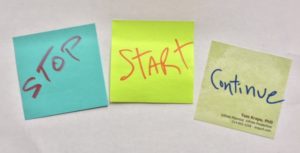
Creating a Feedback Culture: Stop, Start and Continue
October 11th, 2016Feedback is the life blood of high functioning organizations, hence the popularity of 360 methods for creating feedback loops within the organization.
But formalized 360 methods are not the only way to create feedback loops.
I had the great fortune to work with a high potential leader at a Global Fortune 100 company. One of the things I learned about this leader was his reputation within his organization to take whatever team he was working with and increase its effectiveness and impact. It didn’t matter if it was a low functioning team that needed to become high functioning or a high functioning team that was capable of award winning accomplishments (he had led both).
So when I met him, I was curious, wanting to learn more about him, I asked him, “What’s your secret in working with teams?”
He paused and thought for a moment. When he spoke I learned for the first time about the Start, Stop and Continue method. I have shared this story with many executive coaching clients. Here’s what he said.
Tom, after working with a new team for around six months (notice he didn’t go in and just start changing things), I set up one on one meetings with every one of my direct reports.
Stop
I ask them to prepare for the meeting by preparing the most helpful things they can tell me about the things I need to Stop doing. You know, those things that I think are effective but really aren’t.
Start
I ask them to make suggestions about what I could Start doing that would be more helpful to them or the team.
Continue
Finally, I ask them to list anything I should continue doing that is most helpful to them or the team.
Then he said, “But that is only half of the process Tom, I let them know that I will also be preparing the same feedback for them and it will be my turn when they are done.”
He said that the team is never the same after these meetings. It sets the standard for giving and receiving constructive feedback within the team. It encourages individuals on the team to be more helpful to each other by sharing their insights with each other. I encourage us to give more feedback in team meetings as well. For instance, I try to role model a willingness to receive this type of feedback myself within team meetings. This helps people learn when it is appropriate to give this type of feedback in the team setting and how to give it constructively. I also encourage team members to give feedback about what the TEAM needs to Start, Stop and Continue to be more effective.
This method is attributed to Dr. Phil Daniels when he was a psychology professor at Brigham Young University.
Conclusion:
If you want to create a feedback culture, consider using the Stop, Start and Continue method. If you have a “low trust” culture, expect it to take some time for people to warm up to it. In the end you might be amazed by the results.
For a broader discussion about creating a feedback culture see:
https://starcoachshow.com/321-creating-a-feedback-culture-dr-tom-krapu-pcc/
